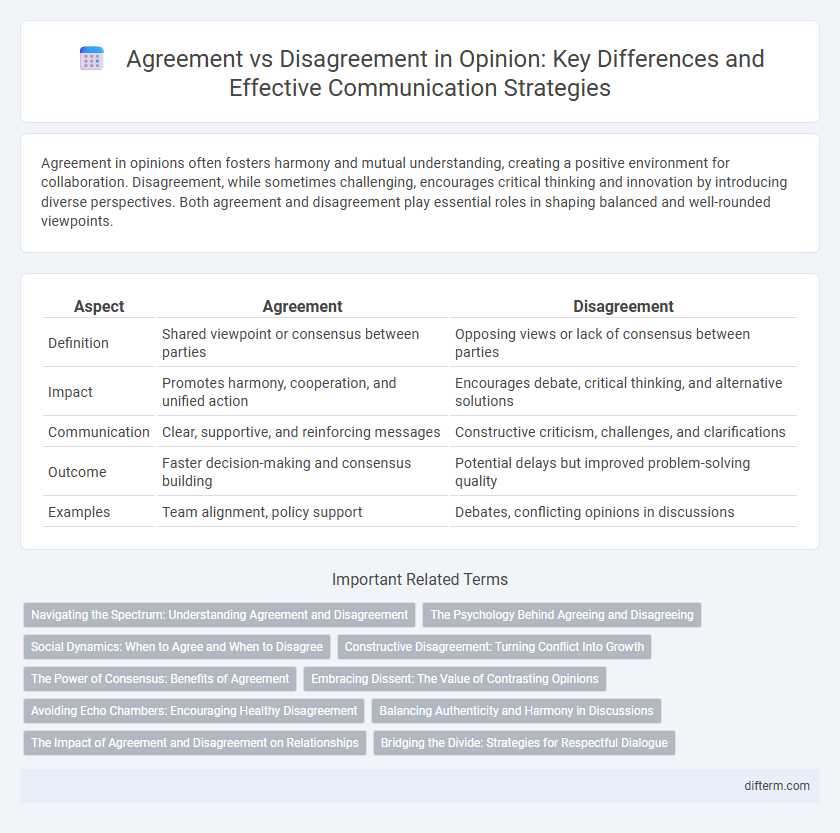Agreement in opinions often fosters harmony and mutual understanding, creating a positive environment for collaboration. Disagreement, while sometimes challenging, encourages critical thinking and innovation by introducing diverse perspectives. Both agreement and disagreement play essential roles in shaping balanced and well-rounded viewpoints.
Table of Comparison
| Aspect | Agreement | Disagreement |
|---|---|---|
| Definition | Shared viewpoint or consensus between parties | Opposing views or lack of consensus between parties |
| Impact | Promotes harmony, cooperation, and unified action | Encourages debate, critical thinking, and alternative solutions |
| Communication | Clear, supportive, and reinforcing messages | Constructive criticism, challenges, and clarifications |
| Outcome | Faster decision-making and consensus building | Potential delays but improved problem-solving quality |
| Examples | Team alignment, policy support | Debates, conflicting opinions in discussions |
Navigating the Spectrum: Understanding Agreement and Disagreement
Agreement serves as a foundation for trust and collaboration by aligning perspectives and fostering mutual understanding. Disagreement, while often perceived negatively, plays a critical role in promoting critical thinking and innovation by challenging assumptions and encouraging diverse viewpoints. Navigating the spectrum between agreement and disagreement requires nuanced communication skills and emotional intelligence to balance conviction with openness.
The Psychology Behind Agreeing and Disagreeing
The psychology behind agreeing and disagreeing reveals that agreement often stems from cognitive biases such as confirmation bias, where individuals favor information that supports their existing beliefs. Disagreement, on the other hand, activates critical thinking and can lead to cognitive dissonance, prompting individuals to reassess their viewpoints. Understanding these psychological mechanisms highlights how social identity and emotional factors influence the dynamics of consensus and conflict.
Social Dynamics: When to Agree and When to Disagree
Agreeing in social dynamics often fosters trust and collaboration by signaling empathy and shared values, which strengthens interpersonal relationships. Disagreeing strategically can stimulate critical thinking and innovation, especially when addressing fundamental issues or challenging groupthink. Balancing agreement and disagreement requires emotional intelligence and situational awareness to maintain harmony while promoting authentic dialogue.
Constructive Disagreement: Turning Conflict Into Growth
Constructive disagreement fosters growth by encouraging diverse perspectives that challenge existing ideas and promote critical thinking. When managed effectively, conflict becomes a catalyst for innovation, strengthening collaboration and deepening understanding among team members. Emphasizing respect and active listening transforms disagreements into opportunities for learning and improved decision-making.
The Power of Consensus: Benefits of Agreement
Consensus drives stronger collaboration by aligning team goals and fostering mutual trust, which enhances productivity. Agreement reduces conflicts and decision-making time, enabling faster implementation of projects and strategies. Shared commitment from consensus often leads to more sustainable and effective outcomes for organizations.
Embracing Dissent: The Value of Contrasting Opinions
Embracing dissent fosters critical thinking and innovation by challenging prevailing assumptions and encouraging diverse perspectives. Valuing contrasting opinions cultivates a culture of openness and intellectual growth, enabling more informed decision-making. Disagreement, when approached constructively, becomes a catalyst for progress rather than division.
Avoiding Echo Chambers: Encouraging Healthy Disagreement
Encouraging healthy disagreement fosters critical thinking and innovation by exposing individuals to diverse perspectives, reducing the risk of confirmation bias inherent in echo chambers. Engaging with opposing viewpoints challenges assumptions and promotes cognitive flexibility, essential for informed decision-making and social cohesion. Cultivating environments where respectful debate thrives enhances collective understanding and prevents the stagnation of ideas within homogenous groups.
Balancing Authenticity and Harmony in Discussions
Balancing authenticity and harmony in discussions requires expressing genuine opinions while respecting differing viewpoints to maintain constructive dialogue. Emphasizing active listening and empathy fosters mutual understanding without compromising personal beliefs. This approach enhances collaborative decision-making and strengthens relationships despite agreement or disagreement.
The Impact of Agreement and Disagreement on Relationships
Agreement fosters trust and strengthens emotional bonds by creating a sense of understanding and alignment between individuals. Disagreement, when managed respectfully, encourages open communication and personal growth, allowing relationships to evolve through diverse perspectives. Persistent unresolved conflict, however, can erode connection and breed resentment, highlighting the importance of constructive dialogue in maintaining healthy relationships.
Bridging the Divide: Strategies for Respectful Dialogue
Bridging the divide in opinion requires active listening and empathy to foster respectful dialogue between opposing viewpoints. Emphasizing shared values and common goals can transform disagreements into productive conversations that promote understanding. Strategies such as asking open-ended questions and validating emotions encourage cooperation rather than conflict, creating a foundation for mutual respect.
agreement vs disagreement Infographic

 difterm.com
difterm.com